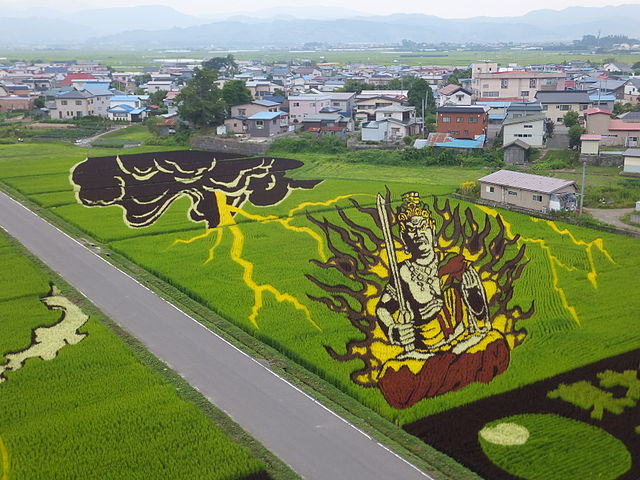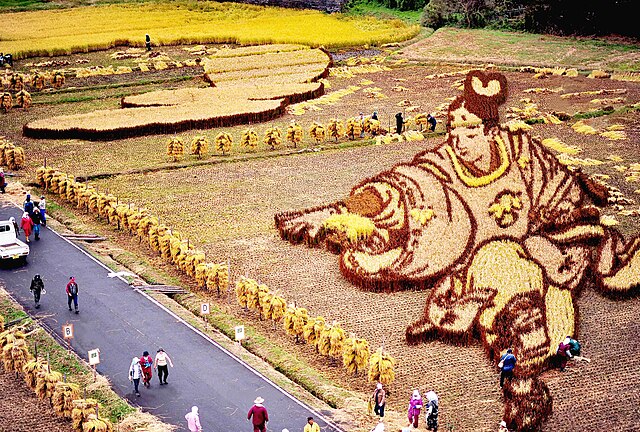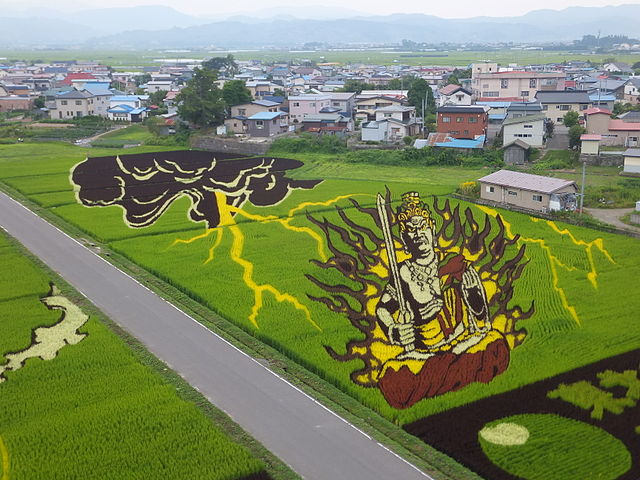Your cart is currently empty!
Watch – Japanese Farmers Turn Rice Fields to Incredible Works of Art to Get People Interested in Farming Again!

At first glance, the countryside of northern Japan is quiet with just rows of rice paddies stretching toward the horizon under the summer sun. But from a single high edge point, the familiar fields transform. Shapes appear where there sounded to be none and colors form scenes that ripple with the breeze. For a fleeting season, the land itself becomes an artwork holding stories that will evaporate as quickly as they bloom.
From Quiet Village to Global Stage
In the northern reaches of Aomori Prefecture lies Inakadate, a farming village of roughly 8,000 residers. Until the early 1990s, it might have been just another rural community still tending its fields. But every June, something remarkable begins to crop in those rice paddies. From observation decks, images spring to life: Mount Fuji, samurai warriors, Mona Lisa, and even anime characters all painted in living rice stalks of green, purple, and gold.

The project began in 1993, when town hall employee Koichi Hanada and about 20 volunteers hand-planted a rice paddy behind the village office to form a simple depiction of Mount Iwaki using three rice varieties differing in color. It was conceived as a reanimation measure in response to population decline and waning interest in agriculture.
Increasing public interest snappily followed. By the early 2000s, the community began integrating computer-aided design (CAD) to correct perspective letting field images from The Great Wave Off Kanagawa to Mona Lisa and the Sazae‑san anime cast render impeccably when viewed from above.
This emulsion of farming tradition and cultural invention has paid off. In peak seasons, the displays soared over 200,000 visitors in 2006, and in 2006 the famed Godzilla motif lured approximately 340,000 spectators.
Inakadate’s rice paddy art has come a living symbol of community adaptability and cultural pride elevating the humble rice field from livelihood to landmark—and reconnecting people, both locals and visitors to the land and its cycles.
How Rice Paddy Art is Made: A Blend of Science, Tradition, and Community
Bringing an Inakadate rice field to life is as scrupulous as any gallery installation, though the canvas is mud and the medium is living stalks of rice. The process begins with precise groundwork: paddies are leveled, gutted, and measured to form an unbroken surface. By early June, farmers and volunteers step barefoot into the soft soil, planting rice seedlings in precisely plotted rows that will later align into a single cohesive image.
The art relies on multiple rice varieties, often seven to ten, chosen for their natural leaf colors, from deep purple to vibrant yellow-green. Up close, the paddies resemble an abstract patchwork. Viewed from an observation tower, the patterns snap into focus, forming mythical scenes, iconic landmarks, or beloved pop‑culture characters.
Timing is everything. By mid‑July, roughly a month after planting, the colors reach full vibrancy. By mid‑August, the display reaches its peak, just before harvest sweeps the artwork away. The transitory nature of the art is part of its charm: by the end of summer, it has returned to its original purpose which is planting rice to be served at dinner tables.
Modern technology supports this living art. Computer‑aided mapping ensures perspective is perfect when viewed from above, and observation decks provide the only vantage points where the full image can be appreciated. Yet the effort remains deeply communal — farmers, schoolchildren, and local volunteers all contribute to planting and upkeep, turning each season’s mural into a celebration of both agriculture and imagination.
Rice Paddy Art Across Japan: A Nationwide Cultural Phenomenon
While Inakadate may be the most famous destination for rice paddy art, the practice has quietly spread across Japan, transforming rural landscapes into seasonal galleries. Known as “tanbo art” (田んぼアート, tanbo āto) or “rice paddy art,” the art form is part of a broader effort to connect people to the land, celebrate indigenous identity, and keep agrarian traditions visible in a fleetly urbanizing country.
Several regions have embraced the conception with each infusing their displays with local culture. In Gyoda City, Saitama Prefecture, rice paddy art has reached record-breaking scale. In 2015, Gyoda’s display earned recognition from Guinness World Records as the world’s largest, covering nearly three hectares. The city’s murals are digitally planned, then planted by volunteers each spring, resulting in vast works best seen from an observation deck. Recent designs have included popular anime characters such as Demon Slayer’s Tanjiro Kamado, blending agricultural creativity with contemporary culture to draw nationwide attention.
Further north, Asahikawa City in Hokkaido began its tradition in 2006, led by the youth club of the Taisetsu Agricultural Cooperative. Using up to six different rice colors, they create vibrant murals that highlight both imagination and the area’s agricultural pride. An eight-meter viewing platform allows visitors to take in the full effect, while the surrounding grounds feature local produce stalls, making the event a blend of visual art and rural community life.
In Yonezawa, Yamagata Prefecture, rice paddy art is used to showcase themes tied to local history and culture, with documented works appearing since the mid-2000s. The city’s murals often draw inspiration from regional heritage, allowing farmers and residents to transform their landscapes into living exhibitions. Though not as internationally publicized as Inakadate or Gyoda, Yonezawa remains a steady contributor to the art form’s regional diversity, proving that tanbo art is as much about community identity as it is about spectacle.
Beyond regional pride, rice paddy art has proven to be a sustainable form of cultural engagement. Unlike painted installations, these murals rely solely on natural rice seedlings that are eventually harvested for food. The fields leave no trace except the renewed curiosity of the visitors they attract. This eco-conscious approach resonates with travelers seeking authentic and environmentally respectful experiences in Japan’s countryside.
Today, rice paddy art isn’t just a local magnet but a civil symbol of rural creativity and adaptability. By blending agriculture, community participation, and art, these seasonal murals remind visitors that Japanese culture thrives not only in its cities and historic temples but also in the quiet rhythm of its farmlands.
Tips for Visiting Inakadate’s Rice Paddy Art
For those inspired to witness Inakadate’s living showpiece, timing and preparation can make the experience truly memorable. Here’s how to make the most of your visit:

1. Plan Your Visit for Peak Season
The rice paddy art is at its most vibrant from mid‑July to mid‑August just before the harvest. Arriving earlier in June will let you see the artwork gradually emerge, while a late‑August visit risks missing the display as fields are cleared.
2. View from Observation Towers
The murals are designed to be appreciated from above. Inakadate offers two main observation points:
- Inakadate Village Office Tower – The original viewing platform with a clear angle of the main field.
- Yayoi no Sato Roadside Station Tower – A second site offering a different mural each year.
These elevated platforms reveal the full precision of the designs, invisible from ground level.
3. Join Planting or Harvest Experiences
For an immersive experience, consider timing your visit to late May or early June when locals and volunteers gather to plant seedlings. Participating in these events offers insight into the artistry and labor behind the murals and some tours also allow visitors to join the autumn harvest.
4. Arrive Prepared for Rural Travel
Inakadate is best accessed via Hirosaki Station on the JR Ou Line, followed by a short local train or bus ride to the village. Trains and buses run on limited schedules, so check timetables in advance. Driving offers flexibility, but parking can be limited during peak weekends.
5. Respect the Fields and Support the Community
These rice paddies are working cropland, not just tourist attractions. Stay on designated paths and observation platforms, and avoid entering the fields. Consider supporting local farmers by copping seasonal produce or souvenirs from nearby stalls. Through this, your visit directly helps sustain the tradition.

By following these tips, travelers can witness the art at its most stunning, connect with the local community, and leave with a deeper appreciation for Japan’s rural creativity.
Art That Lives, Breathes, and Fades With the Seasons
Inakadate’s rice paddy art is more than a spectacle. It is a conversation between land, tradition, and imagination. Each summer, the village transforms its lifeblood into a living gallery, inviting the world to pause and witness beauty rooted in patience and community. And then, just as quickly, it disappears. By autumn, the murals that drew thousands of visitors are gone, harvested into grains that will feed families, leaving only the memory of what once rippled in the fields.
There is a quiet power in art that blooms and fades with the seasons. It reflects the rhythms of rural life, the fragility of tradition, and the strength of a community willing to reinnovate itself without losing its soul. In a world where spectacles often chase permanence, Inakadate’s fleeting masterpieces remind us that some of the most profound experiences are meant to be temporary, seen, felt, and carried home only as inspiration.
Featured image from 掬茶 under CC BY-SA 3.0
